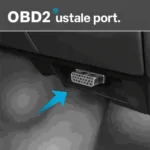The dreaded P0453 code on your 2010 Subaru Forester indicates a small leak in the Evaporative Emission Control System (EVAP). This article will guide you through understanding the P0453 code, diagnosing the issue, and exploring the potential solutions for your 2010 Subaru Forester.
What Does the P0453 Code Mean on a 2010 Subaru Forester?
The P0453 Diagnostic Trouble Code (DTC) specifically points to a small leak detected in the EVAP system. This system is designed to prevent fuel vapors from escaping into the atmosphere. When a small leak is detected, the system triggers the P0453 code. While not an immediate threat to your Forester’s drivability, it’s important to address this issue to maintain optimal fuel efficiency, pass emissions tests, and prevent potential future problems.
Common Causes of the P0453 Code in a 2010 Subaru Forester
Several components within the EVAP system can contribute to a small leak and trigger the P0453 code. These include:
- Loose or Damaged Gas Cap: This is the most common culprit. A loose or cracked gas cap can easily allow vapors to escape.
- Faulty Purge or Vent Control Valve: These valves regulate the flow of vapors within the system. A malfunctioning valve can create a leak.
- Cracked or Damaged EVAP Lines or Hoses: Over time, these lines can become brittle and crack, leading to leaks.
- Leaking Charcoal Canister: The charcoal canister stores fuel vapors. A leak in the canister itself can trigger the P0453 code.
- Faulty Fuel Tank Pressure Sensor: This sensor monitors the pressure within the EVAP system. A faulty sensor can sometimes misinterpret a normal pressure change as a leak.
Diagnosing the P0453 Code in your 2010 Subaru Forester
Diagnosing the P0453 code requires a systematic approach. Here’s a step-by-step guide:
- Check the Gas Cap: Ensure the gas cap is tightened properly. Sometimes, this simple fix can resolve the issue.
- Visual Inspection: Carefully examine all EVAP lines and hoses for visible cracks, damage, or loose connections.
- Use an OBD2 Scanner: A good quality OBD2 scanner can provide more detailed information about the code and help pinpoint the problem area.
- Smoke Test: A smoke test is a highly effective method to locate even the smallest leaks in the EVAP system. A mechanic introduces smoke into the system, and the escaping smoke reveals the location of the leak.
How to Fix the P0453 Code: Solutions for your 2010 Subaru Forester
Once you’ve identified the cause of the leak, the repair process can vary. Here are some common solutions:
- Replace the Gas Cap: This is an inexpensive and easy fix if the gas cap is the culprit.
- Replace Faulty Valves or Sensors: If the purge or vent control valve, or the fuel tank pressure sensor is faulty, replacement is necessary.
- Repair or Replace EVAP Lines: Damaged EVAP lines should be repaired or replaced to prevent further leaks.
- Replace the Charcoal Canister: If the charcoal canister is leaking, it needs to be replaced.
What if I ignore the P0453 Code?
While driving with a P0453 code might not immediately cause noticeable problems, ignoring it could lead to:
- Failed Emissions Tests: Your Forester may not pass emissions tests with an active P0453 code.
- Decreased Fuel Efficiency: A leaky EVAP system can negatively impact fuel economy.
- Potential Future Problems: Ignoring a small leak could lead to a larger, more expensive problem down the road.
Conclusion: Tackling the P0453 Code in Your 2010 Subaru Forester
Addressing the P0453 code in your 2010 Subaru Forester is crucial for maintaining its optimal performance and avoiding potential future issues. By understanding the code, its causes, and the diagnostic process, you can effectively address the problem and ensure your Forester remains in top condition.
FAQ
- Q: Can I drive my car with a P0453 code? A: Yes, you can usually drive with a P0453 code, but it’s best to address it promptly.
- Q: How much does it cost to fix a P0453 code? A: The cost varies depending on the specific cause and repair. A gas cap replacement is inexpensive, while other repairs can be more costly.
- Q: How can I prevent the P0453 code in the future? A: Regularly inspecting your gas cap and EVAP system components can help prevent future leaks.
Need further assistance? Contact us via WhatsApp: +1(641)206-8880, Email: [email protected] or visit us at 789 Elm Street, San Francisco, CA 94102, USA. Our customer support team is available 24/7.


